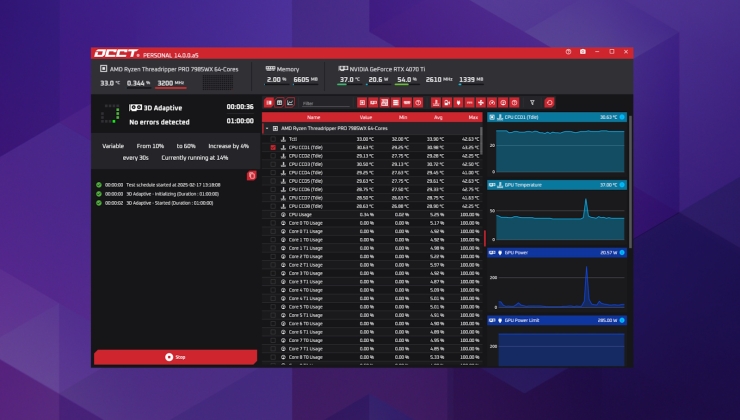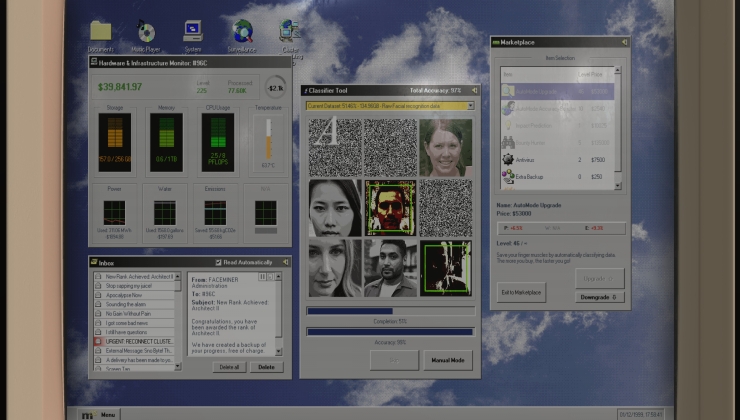Most of us reading this site want Steam Machines to do well. Not all of us will be interested in buying the hardware, but we're aware that its success is also tied to the success of Linux as a gaming platform, which is why I'm pretty miffed that the OEMs and Valve have messed it up.
Valve have done well with the controller and with making SteamOS pretty coherent and user-friendly, but messed it up when it came to defining what a Steam Machine actually is, leaving it open to interpretation. I've said this time and time again, but the original Steam Machines line-up was a complete mess. We had everything from $1500 PCs to ludicrously overpriced machines which didn't even have discreet graphics cards.
Even the best offerings fall short. Alienware's cheapest offering comes in at $450 (this should be the ideal price point in my opinion), but offers a mere 4GB RAM. If you want to scale this up to 8GB, you have to pay $750 since it also means upping the CPU to an i5. Does a GTX 960 need an i5 to do its thing? No, not really. You might get a few extra frames or do better in a more CPU-intensive game, but if one tries to step outside the worldview of a PC gamer and into one of a console gamer, then it doesn't take long to realise that those $200 aren't worth it, but $20 for an extra stick of 4GB RAM would be worth it.
This is perhaps the most frustrating thing. Most of the time, the specs are completely wrong, but when they're not then the price is a serious problem. An Intel i3 and Nvidia 960/1060 series (or AMD equivalent) are the perfect mass market specs for a sofa 1080p gamer just coming off a console. Someone with more needs than that will know how to build a PC and will do it cheaper and better than an OEM.
With the GTX1060 coming out, estimated to have a performance somewhere between a 970 and 980 (probably more on the side of a 980, but I like being conservative) at $250, and if AMD's Zen architecture lives up to the hype and delivers the same price/performance ratio benefits that the Piledriver architecture did, then we could be looking at a new era for the Steam Machine if things are done right this time round.
So what should be done right? First and foremost, deliver the best performance at the lowest cost possible. There is absolutely no room for diminishing returns here, which is why I can't advocate i7s or even i5s. Upgradability would also be a nice plus and a huge selling point if it's approached in a way where a non-technically minded user can get an upgrade easily through using modular designs (there's a lot of possibilities here, but too much to go into for this article). This has the potential to be a massive selling point over this last console generation, which was underpowered on release.
The second, and perhaps more controversial, point is that Valve should really take a few lessons from the console world. By this I mean manufacturing their own machine (which doesn't mean exclusivity). While the idea of everyone building their own box is amicable, the disadvantages far outweigh the benefits. This is what makes consoles so competitive, gives them (historically, not this last generation) great performance compared to PCs on launch at a much better price, with a considerable lifespan.
There's a few reasons for this. Firstly, there's economies of scale, with a single manufacturer pumping out tonnes of machines, the production costs are lower for a number of reasons which this article won't touch upon. Secondly, the benefits of optimisation are tremendous. If everyone is developing for the same hardware, it's easy to accommodate for and optimise a game to get the most out of that hardware - this is one of the main reasons why consoles have such a long lifespan, considering this optimisation also gets better with time. The third reason is simply a retail one, since a high street vendor is far more likely to stock Steam Machines if there's only one option, again for a number of reasons. There's probably more, such as the ability to sell hardware at a loss or a significantly lower profit margin (since that money is made back through game sales), but those are the main ones.
In essence, for Steam Machines to succeed, I would like to see something priced at just over $400 (might be a bit optimistic, but possible with lower profit margins) made by Valve and at those sweet spot specs I mentioned earlier. The original launch was very underwhelming, but there's still a lot of potential to turn things around significantly if Valve come to their senses. Even without them making their own hardware, there's still room for OEMs to improve a lot.
Valve have done well with the controller and with making SteamOS pretty coherent and user-friendly, but messed it up when it came to defining what a Steam Machine actually is, leaving it open to interpretation. I've said this time and time again, but the original Steam Machines line-up was a complete mess. We had everything from $1500 PCs to ludicrously overpriced machines which didn't even have discreet graphics cards.
Even the best offerings fall short. Alienware's cheapest offering comes in at $450 (this should be the ideal price point in my opinion), but offers a mere 4GB RAM. If you want to scale this up to 8GB, you have to pay $750 since it also means upping the CPU to an i5. Does a GTX 960 need an i5 to do its thing? No, not really. You might get a few extra frames or do better in a more CPU-intensive game, but if one tries to step outside the worldview of a PC gamer and into one of a console gamer, then it doesn't take long to realise that those $200 aren't worth it, but $20 for an extra stick of 4GB RAM would be worth it.
This is perhaps the most frustrating thing. Most of the time, the specs are completely wrong, but when they're not then the price is a serious problem. An Intel i3 and Nvidia 960/1060 series (or AMD equivalent) are the perfect mass market specs for a sofa 1080p gamer just coming off a console. Someone with more needs than that will know how to build a PC and will do it cheaper and better than an OEM.
With the GTX1060 coming out, estimated to have a performance somewhere between a 970 and 980 (probably more on the side of a 980, but I like being conservative) at $250, and if AMD's Zen architecture lives up to the hype and delivers the same price/performance ratio benefits that the Piledriver architecture did, then we could be looking at a new era for the Steam Machine if things are done right this time round.
So what should be done right? First and foremost, deliver the best performance at the lowest cost possible. There is absolutely no room for diminishing returns here, which is why I can't advocate i7s or even i5s. Upgradability would also be a nice plus and a huge selling point if it's approached in a way where a non-technically minded user can get an upgrade easily through using modular designs (there's a lot of possibilities here, but too much to go into for this article). This has the potential to be a massive selling point over this last console generation, which was underpowered on release.
The second, and perhaps more controversial, point is that Valve should really take a few lessons from the console world. By this I mean manufacturing their own machine (which doesn't mean exclusivity). While the idea of everyone building their own box is amicable, the disadvantages far outweigh the benefits. This is what makes consoles so competitive, gives them (historically, not this last generation) great performance compared to PCs on launch at a much better price, with a considerable lifespan.
There's a few reasons for this. Firstly, there's economies of scale, with a single manufacturer pumping out tonnes of machines, the production costs are lower for a number of reasons which this article won't touch upon. Secondly, the benefits of optimisation are tremendous. If everyone is developing for the same hardware, it's easy to accommodate for and optimise a game to get the most out of that hardware - this is one of the main reasons why consoles have such a long lifespan, considering this optimisation also gets better with time. The third reason is simply a retail one, since a high street vendor is far more likely to stock Steam Machines if there's only one option, again for a number of reasons. There's probably more, such as the ability to sell hardware at a loss or a significantly lower profit margin (since that money is made back through game sales), but those are the main ones.
In essence, for Steam Machines to succeed, I would like to see something priced at just over $400 (might be a bit optimistic, but possible with lower profit margins) made by Valve and at those sweet spot specs I mentioned earlier. The original launch was very underwhelming, but there's still a lot of potential to turn things around significantly if Valve come to their senses. Even without them making their own hardware, there's still room for OEMs to improve a lot.
Some you may have missed, popular articles from the last month:
All posts need to follow our rules. For users logged in: please hit the Report Flag icon on any post that breaks the rules or contains illegal / harmful content. Guest readers can email us for any issues.




 How to set, change and reset your SteamOS / Steam Deck desktop sudo password
How to set, change and reset your SteamOS / Steam Deck desktop sudo password How to set up Decky Loader on Steam Deck / SteamOS for easy plugins
How to set up Decky Loader on Steam Deck / SteamOS for easy plugins
Sure, you bought it for the 4 year old. Yeah, Right! Tell your fairy tales someone else ;P
Gotcha!;P
First of all, I wonder what kind of Godfather you are. A 4 year old shouldn't play computer games at all. You would have a done a far better job as Godfather if you would have bought him "real" LEGO for that Money.
Second you still can install Windows on a Steam Machine and get access to the full Steam Library. Which is a hell lot more games then you can get on the XBone. But we know already that you didn't buy it for him ;P
Of cause that is partly due to AMD's broken driver history and dated hardware options. Think we will half to wait a good 6-12months before the smoke clears, until we can finally figure out if Steam Machines and SteamOS are going to have a future. If everything is still a shitstorm in another 12months, well .... FAIL
Its below console spec. Buy a PS4 or XB1.. profit.
NVIDIA GeForce GTX GPU 2GB GDDR5
Last edited by TheRiddick on 12 Jul 2016 at 7:47 pm UTC
Can I do anything else with it besides playing games from a very limited pool of games & apps? Most important: Can I run Linux on it?
No? So no profit at all! HUGE FAIL!
Sorry, but I have no use for a locked down Console with PC-Hardware.
Last edited by Crazy Penguin on 12 Jul 2016 at 9:14 pm UTC
It doesn't describe the GPU model...
Well, my 4-year old brother handles the Wii pretty well, but getting a console specifically for a 4-year old I'm assuming is a single child? How are her hands big enough to even effectively use a PS3 controller (my brother can't)?
And how are you going to do that when drivers are crap on Linux, so called "ports" are crap, cheapest hardware manufacturer has crap support on Linux etc.
At this moment Steambox is quite opposite of quoted text, it is worst performance for the highest price and cherry on top is shitload of Linux specific bugs in games and steam that no one is fixing for 4 years.
I am going to buy my gaming machine. Right now it's a 3 way tie for me.
Amazon warehouse deals --
1) First this - https://amzn.com/B015PYYDMQ at $699 open box
This is a Dell 15.6-Inch Gaming Laptop (6th Gen Intel Quad-Core i5-6300HQ Processor up to 3.2GHz, 8GB DDR3, 256GB SSD, Nvidia GeForce GTX 960M 4gb gddr5
plus I just need to add this 2tb hdd https://amzn.com/B00I8O6OQ4
Pro's - I can wipe the OS and install Steam OS or more likely KDE Neon plus steam and Kodi (lets not get into a distro argument, that's the 2 I'm going to choose from) and load some games right away while I'm waiting for the hdd to get here.
I get my ssd configured right out the gate, comments say easy access to add ram and hdd and one guy says 9.5mm is perfect. I can bring this to work and show off linux and/or steam at lunch time. It is low power consumption so it does not catch attention from the landlords. Has display plus hdmi so I can game at work or away somewhere else and come home and hook it up to my 27" monitor. Using KDE connect that is pre installed in Neon I can use my phone as a mouse and my bluetooth earphones and I can watch hulu, netflix, youtube, etc.
cons: No steam controller but I already have logitech 710's and I think the controller is still on sale anyways.
2) The Zotac nen open box warehouse deal https://amzn.com/B01A4FLYSW at $749 assuming my credit card refund clears tomorrow but I'll probably get it around a little over $700. Specs are Core i5-6400T Quad-Core NVIDIA GeForce GTX 960 8GB Memory 1TB Hard Drive. Plus I will have to get this 250gb SSD https://amzn.com/B00TGIVZTW
Pro's - It looks nice. It's low power. It has Steam OS already installed, well actually that is not really a pro because I don't want it on the HDD, I want the OS on the SSD plus I want a 2tb hdd not a 1tb or maybe I can get an external bigger one and enclosure and run that through the USB3.0 It has a steam controller with it. It's easier to move around in the bedroom compared to a laptop.
Cons - I have a feeling I'm not going to like the debian desktop.... but do I really need a desktop on it? I already have a laptop with integrated graphics with KDE Neon on it. Maybe I can just use that for watching videos. Last time i looked at it, it seemed like a little work was needed to get to the graphics card in case it gets jarred loose. The Zotac I just got and returned got shocked during shipping and lost connections on a lot - wifi, hdd light would not come on and I had to push down on them plus the graphics never came up so that tells me the graphics card also came loose because the guy says it was fine when he shipped it. This worries me that i will have to learn the whole insides of this thing if I bring it anywhere in my backpack I'll be worried. I've never had a laptop that was sensitive like that.
Interesting note: in comparing the 2 cpu's it says here that the Zotac one is replaceable
http://www.cpu-world.com/Compare/285/Intel_Core_i5_Mobile_i5-6300HQ_vs_Intel_Core_i5_i5-6400T.html
Imagine in the future Zotac contracts to make the Steambox in mass and puts an access panel for the graphics card and has clear easy instructions to replace both the cpu and gpu the same way they have the drives and ram?
3) Build this http://pcpartpicker.com/guide/gCKH99/great-gaming-build minus the gtx 1070 wait until the 1060 comes out and buy it for $250 and in the mean time I have a spare gtx 750 just sitting here so I could install all my steam stuff while I am waiting.
Pros - everything
Cons - attracts negative attention from landlord. Previous tenant worked at home and drove the electricity up really high. Stationary.
Last edited by aironeous on 14 Jul 2016 at 4:42 am UTC
Heheh, yep. This closely matches my leading conspiracy theory: path of least resistance for Valve. Spend a little effort to get Linux looking like at least a *potential* threat, with all the pieces in place to potentially explode - if Valve were to get unhappy and see no other choice but to fully back it again.
And if that gets MS playing nice with them again, Why put more effort into it than that? Valve can cruise indefinitely in their 95% market. Steady high profits, no extra costs, no extra risks. Save that Linux card for if MS ever decides to play not nice with them again.
It might not be what's really going on. But if it's not, it's one of those invalid theories that accidentally happens to match well with the observed data to this point X-)